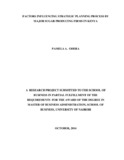| dc.description.abstract | An organization’s strategy consists of many factors that form a formula or roadmap to
provide guidance concerning the organization’s goals, how it will go about attaining
these goals and the tactics and policies that are needed to attain those goals (Porter,
1980). With the many components of strategy, management’s understanding and use of
strategy as a tool to ensure business success has been an important issue for many
decades. This is further compounded by the competitive nature of business in the modern
world, makes strategic planning an essential process for all organizations. It is through
this process that organizations develop sustainable, relevant and valuable vision and
mission statements, objectives and core values to reflect their relevance and intent.
During the strategic planning process the organization need to critically define their
capabilities, resources and match them in order to achieve its set objectives while
evaluating the external environment, other key players and their effect on the
organization. The strategic planning process requires that an organization defines the
strategies that will best fit their resources and capabilities to the external and internal
demands of the environment. Strategic planning is therefore effective in establishing the
organization long term directions and ensures that the organization looks into the future
and assumes a proactive posture. The Sugar industry has faced tremendous growth since
inception and has gone through various changes in terms of regulations and liberalization
thus increasing competition for Sugar and its products. Strategic Planning has enabled the
Sugar firms to stay relevant and continue in operations in the complex, turbulent, political
and competitive environment. The study sought to identify the factors influencing the
strategic planning by major sugar producing firms in Kenya. The Target population of the
study was the four major sugar producing firms who account for 70% of the total sugar
produced in Kenya with wide experience in the industry. The study managed to obtain
responses for 15 out of 20questionnaires from the four major sugar producing firms
which was a 75% response rate. Primary data was collected using semi- structured
questionnaire. The respondents targeted were managers involved in the strategic planning
process in their organization. The questionnaire was administered through email and
follow up by phone calls to the target population. The data was coded and entered into
Statistical Software for Social Science (SPSS) and descriptive analysis ran. The measures
of central tendency were applied on the data and findings, conclusions; recommendations
were summarized in the study. The data presented using bar graphs, percentages and
frequency tables. The study concluded that all the major sugar producing firms have a
formal documented vision and mission statement, however the factors influencing the
strategic planning process were not consistent with the main objectives of the strategic
planning but were more legislative than business oriented | en_US |

